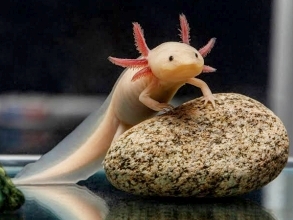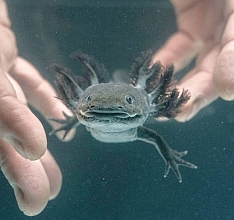   The axolotl (pronounced AX-oh-lot-ul), is a type of salamander. Naturally occurring in Lake Xochimilco and Lake Chalco south of Mexico City, these fascinating creatures are rarely seen in person.
The axolotl (pronounced AX-oh-lot-ul), is a type of salamander. Naturally occurring in Lake Xochimilco and Lake Chalco south of Mexico City, these fascinating creatures are rarely seen in person.Unlike other salamanders, axolotls keep juvenile characteristics into adulthood. They remain aquatic their entire life. Axolotls develop functional lungs, but use feathery gills to breathe underwater. Little is known about their behaviour and ecology because of their small and difficult to access populations.  What is known about axolotls has been obtained from laboratory colonies. Axolotls are normally dark-coloured, but can shift their hue a few shades lighter or darker for camouflage. Pink and light-colored axolotls are bred by humans as pets for their 'pleasing' shades.
What is known about axolotls has been obtained from laboratory colonies. Axolotls are normally dark-coloured, but can shift their hue a few shades lighter or darker for camouflage. Pink and light-colored axolotls are bred by humans as pets for their 'pleasing' shades.Axolotls are typically about 20-25 centimetres long. An axolotl's mouth mouth is often bent into a slight grin; its round, dark eyes have yellow, iridescent irises. It has lizard-like limbs that carry it along the lake bottom.  Axolotls are great night predators, inhaling worms, mollusks, crustaceans, insect larvae, and even small fish! During the day, they burrow into vegetation and mud to avoid being eaten. While they use their gills to breathe underwater, they may pop up to the surface for a quick gulp of air from time to time.
Axolotls are great night predators, inhaling worms, mollusks, crustaceans, insect larvae, and even small fish! During the day, they burrow into vegetation and mud to avoid being eaten. While they use their gills to breathe underwater, they may pop up to the surface for a quick gulp of air from time to time.The axolotl has few predators in the wild, although it may occasonally be eaten by large wading birds and large fish. The biggest threat to axolotl populations is pollution of the freshwater lakes and ponds they inhabit. Axolotls are studied in the lab because of their ability to regenerate their limbs, lungs, heart, jaws, spines, and even parts of their brain! Scientists have found that axolotls can regrow a new limb five times perfectly, in a few weeks, without even a scar. Every tissue is replaced: skin, bone, cartilage, muscle, and stem cells. Other organs can regenerate countless times and be completely functional. Naturally, scientists would like to harness that ability and apply it to human medicine. Axolotls are also over 1,000 times more resistant to cancer than mammals, another characteristic worth investigating. 
|